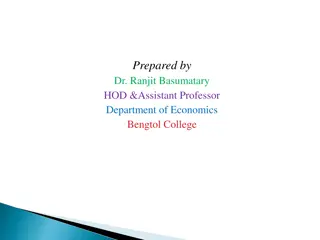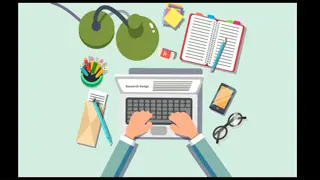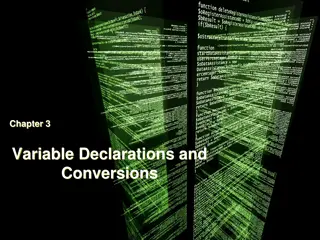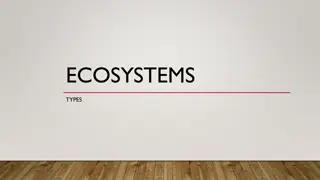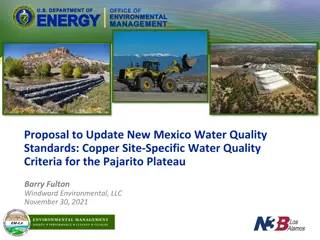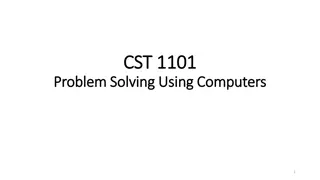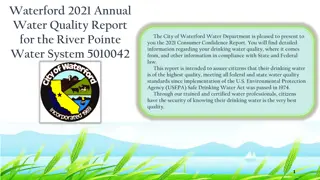Understanding Water Quality Variables and Their Impact on Ecosystems
Water quality variables play a crucial role in natural ecological systems and human water use. Factors like mineral concentrations, toxins, and disease organisms affect the suitability of water for various purposes such as drinking, livestock, irrigation, and industrial use. Density and temperature of water also influence its properties, with salinity affecting density stratification in estuaries. Monitoring and managing these water quality variables are essential for maintaining healthy water ecosystems and sustainable water use practices.
Download Presentation

Please find below an Image/Link to download the presentation.
The content on the website is provided AS IS for your information and personal use only. It may not be sold, licensed, or shared on other websites without obtaining consent from the author. Download presentation by click this link. If you encounter any issues during the download, it is possible that the publisher has removed the file from their server.
E N D
Presentation Transcript
Any physical, chemical, or biological property of water that effects natural ecological systems or influences water use by humans is a water quality variable. There are literally hundreds of water quality variables, but for a particular water use, only a few variables usually are of interest.
Drinking concentrations of minerals, it must be free of toxins, and it must not contain disease organisms. Water for livestock does not have to be of human drinking water quality, but it must not cause sickness or death in animals. Excessive concentrations of minerals in irrigation water have adverse effects on plants, and irrigation water also must be free of toxic substances. Water for industry also must be of adequate quality for the purposes for which it is used. water must not have excessive
Density of water: The density of liquid water increases as temperature rises reaching maximum density of 1.000 g/cm3at 3.980C. Further warming causes the density of water to decrease One cubic meter of pure water at 10 999.70 kg; the same volume weighs 995.65 kg at 30 0C. 0C weighs
The relationship between salinity and density reveals that water at 200C with 30 g/L salinity has a density of 1.0210 g/cm3as compared to 0.99821 g/cm3for freshwater at the same temperature. This is a weight difference of 22.79 kg/m3. Differences in density related to salinity commonly cause density stratification in estuaries where rivers run into the sea.
Temperature of water: Temperature is a measure of the internal thermal energy content of water. Heat content (the amount of thermal energy) is a function of temperature and volume. A liter of boiling water (1000C) in a beaker has a high temperature but small heat content when compared to water at 200C in a reservoir of million m3volume.
Water temperature in small lakes and in ponds closely follows air temperature. Because water can store much heat, larger bodies of water require time to warm up in the spring and to cool down in the temperature of large reservoirs and lakes tend to lag air temperatures. Stream temperature is effected by many factors such as slope and turbulence, precipitation, and forest cover. Nevertheless, there usually is a relatively good correlation between air temperature and stream temperature especially for smaller streams. autumn. Therefore, the
Effect of temperature and density on lakes: Heat is absorbed more strongly and more quickly within the upper layer of water than in lower layers. The transfer of heat from upper to lower layers of water depends mainly upon mixing by wind. Density of water is dependent upon water temperature. Ponds and lakes may stratify thermally, because heat is absorbed more rapidly near the surface making the upper waters warmer and less dense than the deeper waters.
Stratification occurs when differences in density between upper and lower strata become so great that the two strata cannot be mixed by the wind The stratum between the upper layer and the lower layer has a marked temperature difference. which drops at a rate of at least 10C/m. The depth of this layer conditions. may fluctuate depending upon weather
At the end of winter in a lake or pond, the water column Although heat is absorbed at the surface on sunny days, there is little resistance to mixing by wind and the entire volume circulates and warms. has a relatively uniform temperature. As spring progresses, the upper stratum heats more rapidly than heat is distributed from the upper stratum to the lower stratum by mixing
Most large lakes do not destratify until autumn when air temperatures decline and surface waters cool. The difference in density between upper and lower strata decreases until wind mixing causes the entire volume of water in a lake or pond to circulate and destratify. There are several other patterns of lake stratification and periods of free circulation in lakes
Small water bodies with average depths of 1 m or less often thermally stratify during daylight hours, but they destratify at night when the upper layers cool by conduction. The stability of thermal stratification in a water body is related to the amount of energy required to mix its entire volume to a uniform temperature. The greater the energy required, the more stable is stratification.
In tropical region, some large deep lakes tend to be permanently stratified, destratify as the result of weather events. but most occasionally Events that can lead to sudden destratification of water bodies are strong winds that supply enough energy to cause complete circulation, cold, dense rain falling on the surface that sinks through the warm upper layer.
The stratification may occur in areas where waters of different discharge into the ocean, freshwater will tend to float above the salt water because it is less dense. density of water varies with salinity, so salt contents converge. Where rivers
Stratification has a clear effect on lakes water quality. For example, light penetration into the lower layer is inadequate for photosynthesis. Organic particles settle into the Lower layer, and microbial activity causes concentrations to decline and carbon dioxide concentrations to increase. dissolved oxygen Lower layer water often is of low quality, and sudden destratification of lakes with mixing of Lower layer water with upper layers of water can lead to water quality deterioration.



